Hope you are having a good Father’s Day weekend, for those who are privileged to call it your day. Nothing can make Father’s Day better than coming off a positive and profitable week. Given the recent number of profit targets we have taken in several of our investment strategies, our hope is that you are participating along with other subscribers and investors. Here is to continued successful investing!
The Inflation Tightrope (according to Bloomberg.com)
Over the last 14 months, the Fed has been trying to bring down inflation by raising interest rates without tipping the U.S. economy into a recession. Navigating this sort of “soft landing” for the economy may prove difficult because higher interest rates increase borrowing costs for both companies and consumers, slowing economic activity.
This week, the Labor Department reported that the consumer price index (CPI) rose at an annual rate of 4.1% in May, down from the 4.9% annual gain in April and the 40-year high of 9.1% in June 2022.
Late in May, the Commerce Department reported that the core personal consumption expenditures price index was up 4.7% in April, up slightly from a 4.6% year-over-year gain in March—but well off the 2022 peak of 5.3%. So-called core PCE is the Fed’s preferred measure of inflation, and its long-term target for core PCE inflation is just 2%.
The data above prompted (as expected) the Fed to skip another rate hike.
After 10 consecutive interest rate hikes, the Federal Reserve took a breather at the June meeting.
The Fed’s central committee, the Federal Open Markets Committee, decided to leave the federal funds target rate unchanged at a range of 5.0% to 5.25%. The June pause marks the first policy meeting at which the FOMC has not raised interest rates since it began its monetary policy tightening cycle in March 2022.
The Fed confirmed that it would continue to allow up to $60 billion in Treasury securities and $35 billion in agency mortgage-backed securities (MBS) to roll off its $8.3 trillion balance sheet each month. This policy of so-called quantitative tightening has been an important part of the central bank’s ongoing war against inflation.
The FOMC has been fighting record-high U.S. inflation that took off during the Covid-19 pandemic. A combination of interest rate hikes, slowing economic growth, and a tightening credit market has helped cool off price gains, although experts agree that the job is not quite complete.
The U.S. labor market has remained tight, making the FOMC’s fight against inflation even more difficult.
The Labor Department reported that the U.S. economy added 339,000 jobs in May, exceeded economist expectations of 190,000 new jobs. The Labor Department reported that U.S. wages were up 4.3% year-over-year. The unemployment rate ticked higher to 3.7% in May but remains near 50-year lows.
“[The Fed] should make it clear that the battle’s not over, though the fiercest fighting seems to be,” said Sean Snaith, director of the University of Central Florida’s Institute for Economic Forecasting. “Now, it’s more of a mop-up operation to get these final few points off the inflation rate to hit the 2% target.”
At his post-decision press conference, Fed Chair Jerome Powell acknowledged as much.
“In light of how far we’ve come in tightening policy, the uncertain lags with which monetary policy affects the economy and potential headwinds from credit tightening, today we decided to leave our policy interest rate unchanged and to continue to reduce our securities holdings,” said Powell.
“Looking ahead, nearly all committee participants view it as likely that some further rate increases will be appropriate this year to bring inflation down to 2% over time,” Powell said.
The FOMC now appears to believe its 2% long-term inflation target is in sight, but the June pause may not necessarily mean the Fed has issued its final rate hike of the cycle.
Wall Street got its “pause” but for some reason is ignoring the unexpected elements of the FOMC statement that coincided with the “DOT PLAN” which clearly lays out the graphic to visually represent that the Fed members think the federal funds rate will be higher (NOT LOWER) by the end of the year.
The median Fed dot plan showed two additional rate hikes by the end of 2023. The Fed made it abundantly clear that it is expecting to make two more rate hikes. So much for the rate cuts so many investors were expecting. As we have stated on numerous occasions, we see interest rates staying higher for longer.
Let’s review a few facts about the Federal Reserve:
The Fed on inflation since 2021:
- May 2021: inflation is transitory.
- December 2021: Inflation may not be transitory.
- January 2022: Inflation should fall to 2.5% in December 2022.
- May 2022: Inflation should fall to 4.3% in December 2022.
- January 2023: Inflation will hit 3.5% in December 2023.
- Wednesday, June 14, 2023: Inflation won’t hit the 2% target until after 2024.
Basically, in their narrative, the Fed has gotten every part of this cycle WRONG.
Summary:
- Inflation is currently still at 4.0% in June 2023
- They reiterated their view that 2% inflation is their target.
- They don’t see inflation below 2% for at least another 1.5 years.
- The Fed may have paused, but elevated interest rates are here to stay.
- Higher interest rates burden businesses, especially smaller businesses. They increase the payment on the debt as well. This adds to inflation and likely will not help the cause.
- Higher inflation leads to negative consumer sentiment and that is starting to appear.
- Eventually, people will not be able to keep pace with rising costs and will have to “pull in their spending habits”. We have begun to see signs of this taking place (retail sales are soft and most companies are expecting a lackluster upcoming 2023 holiday season).
- AI is hot because it may provide the “ease” of labor shortages and reduce some of the inflationary pressures.
- Inflation leads to “stagflation” (little growth and rising prices) and that will further wear down/slow the economy.
- Inflation is persistent and very difficult to bring down as evidenced yy how wrong the Fed got it above.
The Fed’s expectation for CPI (Consumer Price Index) shows that consumer prices will come down, albeit slowly:
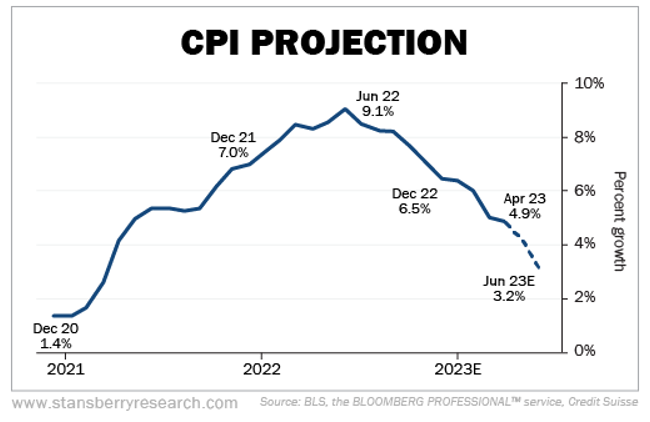

CPI Projection
Since the FOMC meeting on Wednesday, several Fed Governors have voiced their concern about elevated inflation and their “hawkish” view that they see raising rates higher possibly matching the 5.65% high dot that was unveiled on Wednesday.
Richmond Federal Reserve President Tom Barkin this past Friday said that if inflation doesn’t fall closer to the Fed’s target of 2%, he’s comfortable raising interest rates higher.
“I am still looking to be convinced of the plausible story that slowing demand returns inflation relatively quickly to that target,” Barkin said while speaking at the Maryland Government Finance Officer Association. “If coming data doesn’t support that story, I’m comfortable doing more.
The Economic Outlook: Hope for a SOFT LANDING.
- The Fed no longer expects the U.S. to enter a recession in 2023.
- The Fed predicts the unemployment rate will be 4.1% at year-end, down from the previously estimated 4.5%.
- The Fed sees annual gross domestic product rising 1.0% instead of the prior forecast of 0.4%.
- In addition to its monetary policy decision, the Fed updated its long-term economic projections on Wednesday. Committee members now estimate a median fed funds rate of 5.6% in 2023, up from their previous 5.1% projection back in March.
Whether people wish to see it or not, there are several positive signs that the hike in interest rates is working.
Weekly unemployment claims have jumped from the low 200,000s to above 260,000. This is the desired weakness that the Fed wants to see and just one of the “data dependent” numbers they were looking for when they hit the “skip” button this past week.
Besides many of the high-tech companies reducing their job forces, here are some of the other reductions occurring in the service sector. See graph below:
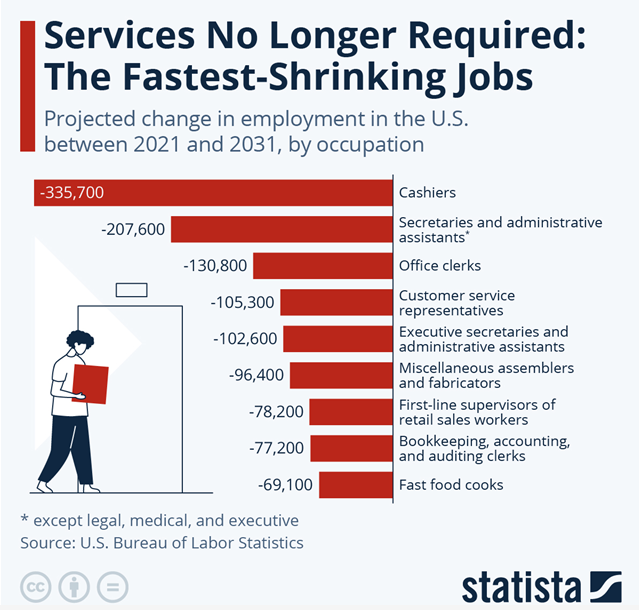

Fastest Shrinking Jobs
In addition. The leading economic indicators (LEI) continue to contract. This on the backdrop of the market climbing higher. See chart below:
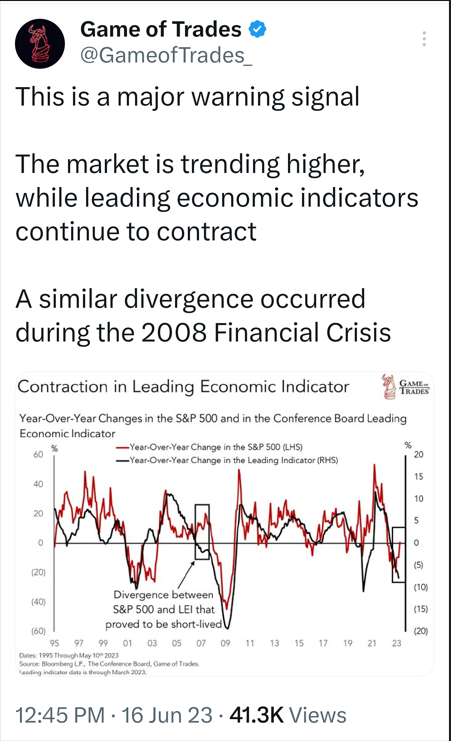

Economic Indicators
Might we see a recession?
Many of the smartest economists and analysts are very divided on this. Given the changing landscape of employment, new job creation, unemployment claims and the rate of unemployment, leading economic indicators and economic growth rates (or lack thereof), many economists, analysts and money managers are still hoping for a soft landing. Equally NOT CONVINCED that this could occur, just as many continue to openly discuss the inevitable or “certain” hard landing and recession that is forthcoming. This was summed up best by Chris Zaccarelli, chief investment officer at Independent Advisor Alliance who, this week, stated:
“The FOMC’s job is not yet complete. We are stuck in no-man’s land where inflation is above target, monetary policy is tight and employers hoard labor,” Zaccarelli says. “We think the longer this persists—effectively a ‘no landing’—the more likely a hard landing scenario becomes because either the Fed will eventually resume raising rates or the economy will eventually run out of steam and we will fall into an old-fashioned recession.”
The Stock Market’s Response (the Bulls run wild)
But wait a minute. If the market thinks we are going to get more rate hikes this year, why did stocks spike to new highs this week?
The answer is that the market doesn’t believe the dots. The dots have a dubious track record of accuracy. Yet even if the dots were accurate, the market isn’t really as concerned with what the Fed does as it once was.
We also believe strongly that the fear sentiment about stocks got way too negative and there is an abundance of cash sitting in money market funds (approximately $5 trillion) waiting to find a home for better returns than cash. Some of this money is working its way into the markets heavily driven by FOMO (fear of missing out).
A good week in the markets.
Given the still hawkish rhetoric of the Fed on Wednesday, the stock market shrugged it off and continued higher. See a recap of this past week below:
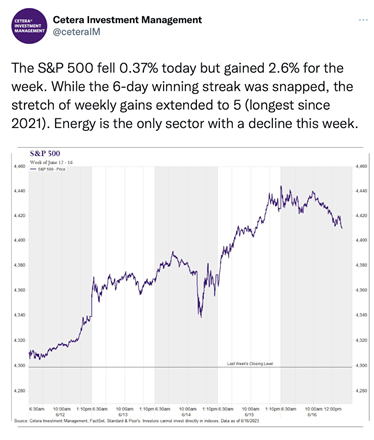

S&P 500 Chart
Fear has subsided.
The just hit 13.50, it’s lowest level since December 2019. This measure of fear and volatility in the markets is now below pre-pandemic lows as the hit fresh month highs. VIX is now down 56% in just 3 months since the collapse of Silicon Valley Bank (SVB). See chart below:
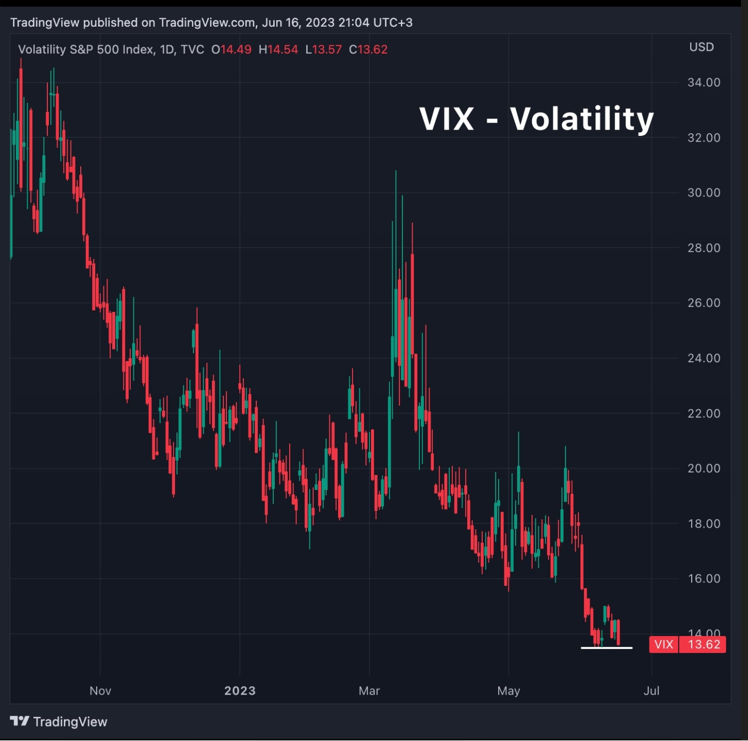

A Move Higher
The S&P 500 has put on quite a show over the past three months – rallying 500 points and hitting its highest level in more than a year. Here is a summary of the stock market’s recent move:
- The S&P 500 was up 3% on the week, the best week since March 2023
- The S&P 500 is up 5 straight weeks, best winning streak since November 2021
- The S&P 500 is now up 26% from bear market low
- The Nasdaq is up 4% on the week, best week since March, 2023
- The Nasdaq is up 8 weeks in a row, best winning streak since 2019
- Both the Nasdaq and the S&P 500 are up 6 days in a row through Thursday
- The Dow Jones was up 2% for the week, 3rd positive week in a row
- The S&P 500 and Nasdaq are at the highest prices since April 2022
The Fed week did not disappoint.
Not many on Wall Street were able to call the huge S&P 500 comeback this year after the index plummeted into its first bear market in a generation last year. The one analyst who got it right was Tom Lee.
Back in December, the veteran analyst and cofounder of Fundstrat Global Advisors argued that the S&P 500 would jump more than 20% this year to 4,750—a price target 17% higher than Wall Street’s median forecast. And in March, Lee doubled down on his bullish take, arguing stocks were set to soar due to falling inflation, a dovish Fed, and reasonable valuations after 2022’s dismal year.
Since then, the S&P 500 has rallied nearly 10%, for an over 14% upswing year to date. It’s looking pretty good for Lee’s prognostication, and now he’s back with another big call.
Lee, who is generally known for his bullish forecasts and support of cryptocurrencies, says that stocks will continue their march higher. Despite more than a year of consistent recession predictions from Wall Street (probably amounting to the most widely predicted recession in history), he notes that the economy has remained resilient, with the unemployment rate hovering near pre-pandemic lows and GDP growth continuing in the first quarter.
“I think instead of a recession unfolding, the economy is actually slipping into an expansion,” Wall Street’s biggest bull told CNBC Monday. See a chart indicating this move below:
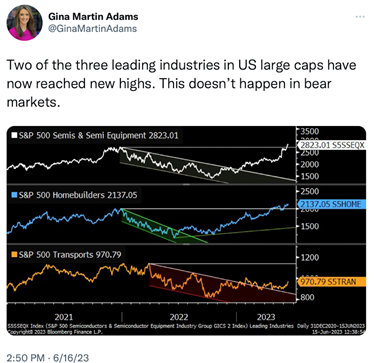

S&P 500 Semis Chart
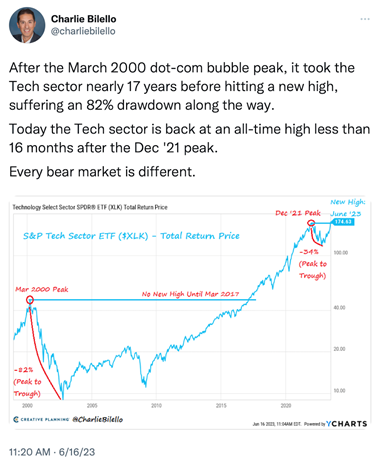

XLK Total Return Price Chart
Getting Stretched
Last week we commented that while we are in this “new bull market” several of the market indicators are getting over extended. The last time we saw the S&P move this far above it’s moving averages was in February where it went through a 300 point pullback before consolidating and moving higher. We may be at the same place today. See chart below:
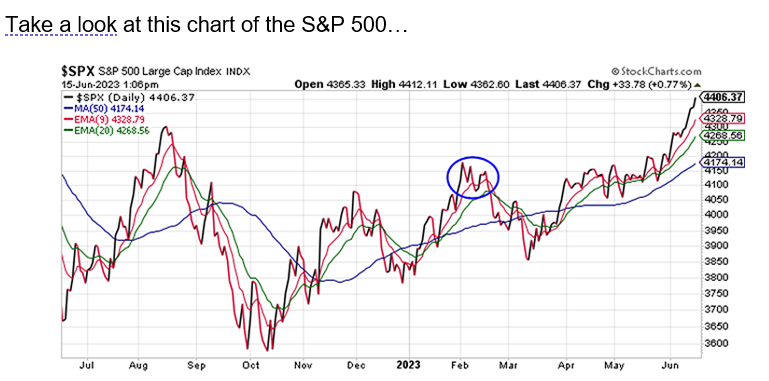

There are other indicators we believe that may be getting ahead of themselves. The American Association of Individual Investors survey has flipped from 19% bullish and 48% bearish on March 15 to 45% bullish and 23% bearish as of Wednesday. And, the VIX is trading near its lowest level in three years! (see VIX info above which in and of itself is a contrarian indicator).
Another technical measure of strength in the markets (the RSI) is getting overbought and indicating that a near-term pullback may be imminent. See chart below:
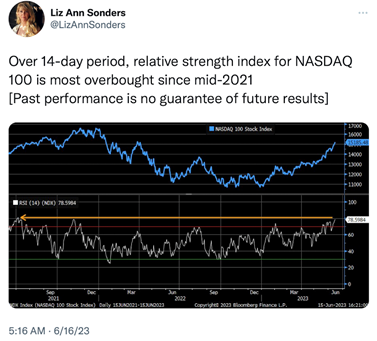

Nasdaq Relative Strength Index
Folks who missed out on the rally over the past three weeks will be anxious to buy into any weakness. So, we’ll likely get one or two bounce attempts before we see any significant selling pressure.
คำแนะนำการอ่านบทความนี้ : บางบทความในเว็บไซต์ ใช้ระบบแปลภาษาอัตโนมัติ คำศัพท์เฉพาะบางคำอาจจะทำให้ไม่เข้าใจ สามารถเปลี่ยนภาษาเว็บไซต์เป็นภาษาอังกฤษ หรือปรับเปลี่ยนภาษาในการใช้งานเว็บไซต์ได้ตามที่ถนัด บทความของเรารองรับการใช้งานได้หลากหลายภาษา หากใช้ระบบแปลภาษาที่เว็บไซต์ยังไม่เข้าใจ สามารถศึกษาเพิ่มเติมโดยคลิกลิ้งค์ที่มาของบทความนี้ตามลิ้งค์ที่อยู่ด้านล่างนี้
Source link








